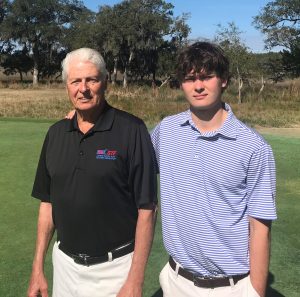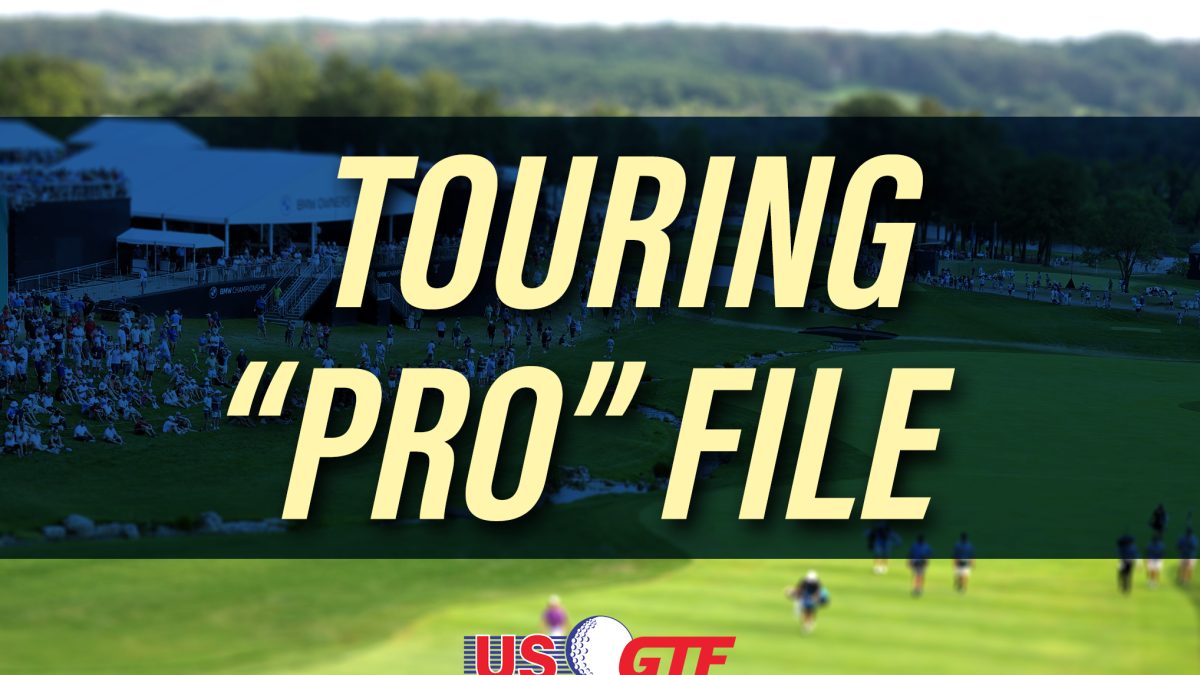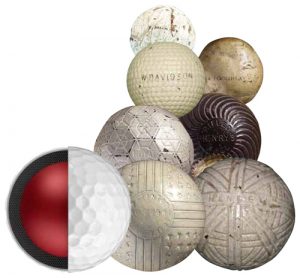Editorial – Caddies – Masters Of The Game
 Virtually ever since golf began, the player has had a faithful sidekick known as a caddie. “Caddie” comes from the French word “cadet,” which loosely translated means the younger.
Films of golf competitions in the past show young people caddying for players such as Ben Hogan and Byron Nelson, and it’s hard to imagine them giving these two greats much advice. Back then, they simply carried the clubs, cleaned the golf balls and tended the flagstick. As professional golf became more of an actual profession where players could earn a full-time income, caddies grew in importance. Their responsibilities evolved into figuring yardages, recommending club selection and reading greens.
Today on all the major tours, caddies are generally good players in their own right, with quite a few transitioning from playing on the PGA Tour to caddying. Perhaps the most notable was Lance Ten Broeck, who had a decent playing career before taking up the bag of Jesper Parnevik. Others include Jimmie Johnson, longtime caddie for Justin Thomas; Paul Tesori, caddie for Vijay Singh and now Webb Simpson, and Damon Green, a mini-tour legend and former Korn Ferry Tour player who most famously caddied Zach Johnson to two major championships.
Modern caddies often have lengthy discussions with their players before each shot, as witnessed on television. They also have to be psychologists and coaches in addition to caddies, demonstrating varied skills. The best caddie today is considered to be Jim “Bones” Mackay, former caddie for Phil Mickelson and now on the bag of Justin Thomas. Caddies for the best players are also handsomely rewarded, with many of them earning good six-figure salaries. Caddies truly have to be masters of the game in today’s competitive field.
Virtually ever since golf began, the player has had a faithful sidekick known as a caddie. “Caddie” comes from the French word “cadet,” which loosely translated means the younger.
Films of golf competitions in the past show young people caddying for players such as Ben Hogan and Byron Nelson, and it’s hard to imagine them giving these two greats much advice. Back then, they simply carried the clubs, cleaned the golf balls and tended the flagstick. As professional golf became more of an actual profession where players could earn a full-time income, caddies grew in importance. Their responsibilities evolved into figuring yardages, recommending club selection and reading greens.
Today on all the major tours, caddies are generally good players in their own right, with quite a few transitioning from playing on the PGA Tour to caddying. Perhaps the most notable was Lance Ten Broeck, who had a decent playing career before taking up the bag of Jesper Parnevik. Others include Jimmie Johnson, longtime caddie for Justin Thomas; Paul Tesori, caddie for Vijay Singh and now Webb Simpson, and Damon Green, a mini-tour legend and former Korn Ferry Tour player who most famously caddied Zach Johnson to two major championships.
Modern caddies often have lengthy discussions with their players before each shot, as witnessed on television. They also have to be psychologists and coaches in addition to caddies, demonstrating varied skills. The best caddie today is considered to be Jim “Bones” Mackay, former caddie for Phil Mickelson and now on the bag of Justin Thomas. Caddies for the best players are also handsomely rewarded, with many of them earning good six-figure salaries. Caddies truly have to be masters of the game in today’s competitive field.


 The Mizuno Golf, a longtime industry partner with the USGTF, has announced a further discount to USGTF members on all its products. USGTF members in good standing may now purchase Mizuno irons, woods and golf balls for 21% off the listed wholesale price, an increase from the previous 15%. Further, for on-time payment, an additional 5% discount will be offered.
Mizuno irons are known for their outstanding quality and feel, and their driver and fairway wood line is gaining a reputation as well respected as the irons’. To take advantage of this pricing, orders may be placed through the USGTF National Office at (772) 88-USGTF.
The Mizuno Golf, a longtime industry partner with the USGTF, has announced a further discount to USGTF members on all its products. USGTF members in good standing may now purchase Mizuno irons, woods and golf balls for 21% off the listed wholesale price, an increase from the previous 15%. Further, for on-time payment, an additional 5% discount will be offered.
Mizuno irons are known for their outstanding quality and feel, and their driver and fairway wood line is gaining a reputation as well respected as the irons’. To take advantage of this pricing, orders may be placed through the USGTF National Office at (772) 88-USGTF.
 By Graham Lewis, USGTF Professional
Walker Larkin is a junior at Glynn Academy High School in Brunswick, Georgia, and a straight-A student. When Walker was in the 6th grade, he wanted to play on the middle school golf team (the best team in the state). His dad asked me to help Walker improve his game so he could compete. It was clear from the beginning that he loved the game, but was very frustrated with not improving faster. His swing was very athletic and somewhat old school, with a lot of lower body movement and a reverse C with a high finish and more erect posture (ala Johnny Miller).
As we worked on stabilizing the lower body and attaining better posture, he improved enough to make the team. Throughout middle school while working on mechanics, we addressed his frustration and anxiety by setting more realistic goals. He wanted too much too quick. Improvement was slow but evident.
When Walker started high school, his goal was to make the varsity, which was and is one of the very top teams in the state. In an effort to gain more distance, he developed two flaws that we began to address. He was over-the-top in his transition and buried his chin on the downswing. We incorporated the Freddy Couples swing as part of his pre-shot routine and the over-the-top move was cured.
Last year, Walker’s driver swing speed was measured at 112 mph on the GC Quad launch monitor and was hitting down three to five degrees. Recently, he was measured with a slight speed increase but is now hitting up at three degrees, and his distance has improved by 30 yards, resulting in 295-yard drives. We attribute this success to the Couples routine and what I call the thumb-up drill, which has tremendously increased his lag to the point it rivals anyone on tour.
Walker has made the varsity this year and is now breaking 80 routinely from 7,200 yards. His scores don’t reflect the quality of his ball striking, so we are now devoting practice time to better course management. He remains in love with the game of golf, and his dealing with frustration and anxiety continues to improve. He would like to play college golf after he graduates from high school.
By Graham Lewis, USGTF Professional
Walker Larkin is a junior at Glynn Academy High School in Brunswick, Georgia, and a straight-A student. When Walker was in the 6th grade, he wanted to play on the middle school golf team (the best team in the state). His dad asked me to help Walker improve his game so he could compete. It was clear from the beginning that he loved the game, but was very frustrated with not improving faster. His swing was very athletic and somewhat old school, with a lot of lower body movement and a reverse C with a high finish and more erect posture (ala Johnny Miller).
As we worked on stabilizing the lower body and attaining better posture, he improved enough to make the team. Throughout middle school while working on mechanics, we addressed his frustration and anxiety by setting more realistic goals. He wanted too much too quick. Improvement was slow but evident.
When Walker started high school, his goal was to make the varsity, which was and is one of the very top teams in the state. In an effort to gain more distance, he developed two flaws that we began to address. He was over-the-top in his transition and buried his chin on the downswing. We incorporated the Freddy Couples swing as part of his pre-shot routine and the over-the-top move was cured.
Last year, Walker’s driver swing speed was measured at 112 mph on the GC Quad launch monitor and was hitting down three to five degrees. Recently, he was measured with a slight speed increase but is now hitting up at three degrees, and his distance has improved by 30 yards, resulting in 295-yard drives. We attribute this success to the Couples routine and what I call the thumb-up drill, which has tremendously increased his lag to the point it rivals anyone on tour.
Walker has made the varsity this year and is now breaking 80 routinely from 7,200 yards. His scores don’t reflect the quality of his ball striking, so we are now devoting practice time to better course management. He remains in love with the game of golf, and his dealing with frustration and anxiety continues to improve. He would like to play college golf after he graduates from high school.
 After spending 25 years in the business world, Johnny McCosker decided that a career following his passion was the best course of action. So, at age 46, McCosker attended a USGTF certification course and began his second career.
He had played high school and college golf, but that went on the backburner as he forged a business career, first with Stanley Works (the tool company) for eight years and then in the insurance world in New England for the next 15. He talked things over with his wife and then took the leap of faith in 2004 in becoming a USGTF member.
“I just find it so much fun, enjoyable, satisfying and rewarding,” said McCosker of his golf career. “And seeing kids grow up and being part of their lives is really special.” McCosker has spent the last 13 years at The Quechee Club in Quechee, Vermont, one of the state’s best private, four-season recreation and golf facilities, as an assistant golf professional, and for five years was the junior coordinator, He greatly increased the participation in ladies’ league play by more than 50 percent, and designed instruction clinics specifically for women in improving golf skills and increasing their enjoyment of the game.
He recently stepped back from his position at Quechee in order to renovate a home in Vero Beach, Florida. He plans to play more golf, improving his game and resume his teaching career once his house is finished. McCosker also is involved in club fitting and repair, another passion of his. And having the best of both worlds, he plans to play with friends and members at Quechee when he’s in Vermont for the summer.
McCosker has developed a number of good players, with one currently having professional aspirations. “I’ve had a great career developing so many relationships,” he commented.
After spending 25 years in the business world, Johnny McCosker decided that a career following his passion was the best course of action. So, at age 46, McCosker attended a USGTF certification course and began his second career.
He had played high school and college golf, but that went on the backburner as he forged a business career, first with Stanley Works (the tool company) for eight years and then in the insurance world in New England for the next 15. He talked things over with his wife and then took the leap of faith in 2004 in becoming a USGTF member.
“I just find it so much fun, enjoyable, satisfying and rewarding,” said McCosker of his golf career. “And seeing kids grow up and being part of their lives is really special.” McCosker has spent the last 13 years at The Quechee Club in Quechee, Vermont, one of the state’s best private, four-season recreation and golf facilities, as an assistant golf professional, and for five years was the junior coordinator, He greatly increased the participation in ladies’ league play by more than 50 percent, and designed instruction clinics specifically for women in improving golf skills and increasing their enjoyment of the game.
He recently stepped back from his position at Quechee in order to renovate a home in Vero Beach, Florida. He plans to play more golf, improving his game and resume his teaching career once his house is finished. McCosker also is involved in club fitting and repair, another passion of his. And having the best of both worlds, he plans to play with friends and members at Quechee when he’s in Vermont for the summer.
McCosker has developed a number of good players, with one currently having professional aspirations. “I’ve had a great career developing so many relationships,” he commented.

 1. Complimentary digital WGTF membership cards. These digital cards are accessible anywhere in the world for quick member validation.
2. Worldwide recognition and prospects for both business and social purposes.
3. Membership opportunities with the International PGA,
1. Complimentary digital WGTF membership cards. These digital cards are accessible anywhere in the world for quick member validation.
2. Worldwide recognition and prospects for both business and social purposes.
3. Membership opportunities with the International PGA,  If you have not yet paid your 2022 membership fees, the time to do so is now! The scheduled increase in late fees, which was due to take place on March 1, has been extended one week. After March 7, the late fee will be $50. Please
If you have not yet paid your 2022 membership fees, the time to do so is now! The scheduled increase in late fees, which was due to take place on March 1, has been extended one week. After March 7, the late fee will be $50. Please  According to the National Golf Foundation, from 2000 to 2019, the number of rounds played in the United States steadily decreased, and many courses closed. When the COVID-19 pandemic hit the world in 2020, people turned to golf as a safe, outdoor activity since so many other activities were shuttered, and the number of rounds played was the highest since 2002. But, would that momentum continue into 2021?
According to the National Golf Foundation, from 2000 to 2019, the number of rounds played in the United States steadily decreased, and many courses closed. When the COVID-19 pandemic hit the world in 2020, people turned to golf as a safe, outdoor activity since so many other activities were shuttered, and the number of rounds played was the highest since 2002. But, would that momentum continue into 2021? When golf was first played in Scotland in some form that would be familiar to us today, the ball might have been made out of wood, although this is speculation. A ball stuffed with hair in a leather pouch was played, and then the featherie became the norm. It consisted of wet feathers stuffed in leather. When the feathers dried, the ball expanded into a hard, playable sphere. The first mention of a featherie was in the 1600s, although there is evidence the ball was played at least 100 years prior.
The featherie lasted a long time, until the 1840s, when a Scottish divinity student named Robert Paterson came across a shipment of gutta percha and attempted to make some golf balls out of it. He was eventually successful, and as the gutta percha ball went farther, was more durable and cheaper than the featherie, the featherie’s long era came to an end. Gutta percha balls didn’t last long as in the 1890s, American businessman Coburn Haskell invented the wound golf ball, and in 1901 the Haskell Golf Ball Company was founded. The wound ball with a balata cover became the ball of choice for decades.
The balata ball was popular on the professional circuits until 2000, but in 1972 Spalding introduced the two-piece Top Flite golf ball with a Surlyn cover, revolutionizing the game yet again, especially for amateurs. Weekend warriors now had a durable ball that spun less and produced more distance. In 2000, Callaway Golf came up with the modern tour ball, the Rule 35, with a layered ionomer core and a urethane cover. Titleist and every ball manufacturer soon followed suit, and this construction is still considered premium.
OnCore Golf began as an idea in 2008 with a metal-core golf ball, another innovation, and since then has only grown bigger. Today the company has three balls, the Elixr, Vero X1 and the Avant 55 to appeal to all ranges of golfers. With OnCore and others leading the way, golf ball innovation is sure to continue.
When golf was first played in Scotland in some form that would be familiar to us today, the ball might have been made out of wood, although this is speculation. A ball stuffed with hair in a leather pouch was played, and then the featherie became the norm. It consisted of wet feathers stuffed in leather. When the feathers dried, the ball expanded into a hard, playable sphere. The first mention of a featherie was in the 1600s, although there is evidence the ball was played at least 100 years prior.
The featherie lasted a long time, until the 1840s, when a Scottish divinity student named Robert Paterson came across a shipment of gutta percha and attempted to make some golf balls out of it. He was eventually successful, and as the gutta percha ball went farther, was more durable and cheaper than the featherie, the featherie’s long era came to an end. Gutta percha balls didn’t last long as in the 1890s, American businessman Coburn Haskell invented the wound golf ball, and in 1901 the Haskell Golf Ball Company was founded. The wound ball with a balata cover became the ball of choice for decades.
The balata ball was popular on the professional circuits until 2000, but in 1972 Spalding introduced the two-piece Top Flite golf ball with a Surlyn cover, revolutionizing the game yet again, especially for amateurs. Weekend warriors now had a durable ball that spun less and produced more distance. In 2000, Callaway Golf came up with the modern tour ball, the Rule 35, with a layered ionomer core and a urethane cover. Titleist and every ball manufacturer soon followed suit, and this construction is still considered premium.
OnCore Golf began as an idea in 2008 with a metal-core golf ball, another innovation, and since then has only grown bigger. Today the company has three balls, the Elixr, Vero X1 and the Avant 55 to appeal to all ranges of golfers. With OnCore and others leading the way, golf ball innovation is sure to continue.